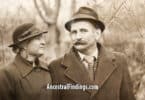If you have Russian heritage, you may be curious about how your Russian ancestors celebrated Christmas. After all, this information is important to understand how your ancestors lived, what their beliefs were, and what kind of people they were. These are all important things for a genealogist to know about their ancestors, as the knowledge helps bring us closer to them, even across vast swaths of time, even centuries. This is because holidays and religious traditions are some of the very few things that can connect people who are centuries apart because they rarely change (or if they do, they only do a very little). These are the most important things you need to know about the Russian Christmas traditions of your ancestors.
The Beginnings of Christmas in Russia
Christmas first became an official holiday in Russia in 988 A.D. by an order from Prince Vladimir. This was the year that Prince Vladimir converted to the Eastern Orthodox Christian church, after traveling to Constantinople and witnessing many miracles performed thereby Saint Nicholas (the inspiration for the Santa Claus we know today). When he returned home, all the residents of Kiev were baptized in a mass ceremony. After that, Orthodox Christianity was the law of the land in the region that would one day become Russia. Christmas was celebrated until the Bolshevik Revolution in 1917 when the atheist regime banned Christmas as a religious tradition (the official ban did not come until 1929, but it was discouraged after the revolution until then). Christmas trees were banned in 1935. However, people kept buying them and putting them up in their homes, because the new Soviet government decreed that New Year’s Day was to replace Christmas as the biggest, most important celebration of the Russian year. So, the Christmas trees were turned into New Year’s trees.
People still celebrated Christmas in Russia after the ban. They just had to do it in secret. This was true from the official ban until the Soviet Union fell in 1991. Once the Soviet Union was no longer a country, and Russia returned from her long exile, Christmas celebrations were made legal once more. However, after six decades of Christmas being banned and New Year’s being promoted, Christmas came back to Russia as a quieter, less important holiday than it had been before the Bolshevik Revolution. The New Year’s celebration is still the bigger holiday in Russia in modern times. New Year’s is a big, public holiday with lots of spending, drinking, and eating, while Christmas is quieter and more private, and with the religious practices that are not included in New Year’s celebrations.
New Russian Christmas/New Year’s Traditions
The Bolsheviks, and later Soviets, even re-appropriated the Christmas gift-giving tradition of Christmas to New Year’s. New Year’s Day is now the time when Grandfather Frost (also called Ded Moroz in Russian) brings gifts to children. Grandfather Frost carries a large, magical staff, and has a sidekick, his granddaughter who is named Snegurochka (aka The Snow Maiden). Grandfather Frost and Snegurochka replaced the visits of Saint Nicholas, who had previously been venerated on Christmas as in other Christian nations, before the Bolshevik Revolution in Russia.
On New Year’s Eve, Russian children hold hands with each other and stand around the Christmas tree (or New Year’s tree, depending on if their family is religious or secular), and call out for Grandfather Frost and Snegurochka to come and bring them presents.
The children know Grandfather Frost and Snegurochka have arrived when the lights on the tree and the star on top of it light up. The children then cheer and greet each other with the traditional Russian New Year’s greeting of S Novym Godom.
The focus on New Year’s Eve and Day over Christmas in Russia is not the only difference in how Russia celebrates Christmas compared to other western countries. Christmas is actually celebrated in Russia on January 7, with the exception of a handful of Catholics in the nation who celebrate on the traditional December 25. This difference in celebration dates is because the Russian Orthodox Church uses a different calendar for religious celebrations than for the other times of the year. It uses the old-fashioned Julian calendar for these holidays and the more modern Gregorian calendar for everything else.
Advent is celebrated in the Russian Orthodox Church, but it has fixed dates, unlike many other areas of the world. It is celebrated from November 28 to January 6. In Russia as a whole, the official national celebration dates for the Christmas and New Year’s holidays are December 31 to January 10.
People who celebrate Christmas in Russia do say “Merry Christmas” to others to commemorate the holiday. In Russian, this is pronounced as C рождеством (s rah-zh-dee-st-VOHM).
Traditional Russian Christmas Traditions
When it comes to actually celebrating Christmas in Russia, those who do it today tend to do it the way it was done in the past, before it was banned. This is where Russian Christmas traditions can tie you into your Russian ancestors and the way they lived their lives and celebrated the religious holidays. You might even consider adopting some of these traditions into your own family celebrations to honor your Russian ancestors and heritage.
Fasting on Christmas Eve: It has been traditional for a long time for those who can to fast on Christmas Eve. They don’t eat anything all day until the first star of the evening appears in the sky (the star symbolizes the star that led the Magi to Jesus in the manger at his birth). Granted, with the shorter days in Russia this time of year, they don’t actually go all that long without eating, just enough to get hungry for Christmas Eve dinner. When they break their fast in the evening, they eat porridge made from wheat or rice and served with honey and fruit, poppy seeds, and chopped walnuts. The porridge is called sochivo. It is standard practice with the Russian Orthodox Church to avoid eating meat or fish on Christmas Eve. This is why sochivo has neither of these things in it.
Kutia: Kutia is another name for sochivo. It is made the same way and eaten on Christmas Eve after the fast. However, there are a couple of important differences that distinguish sochivo from kutia. First, kutia is usually eaten out of a common family bowl to symbolize unity among the family. Also, a spoonful of it is typically thrown on the ceiling. The legend has it that if the spoonful of kutia sticks to the ceiling, the family will have good luck and a good harvest in the new year.
Other Christmas Eve Traditions in Russia: Sochivo and kutia aren’t the only foods traditionally eaten on Christmas Eve in Russia after the end of the fast. Other traditional Christmas Eve foods include beet soup (aka borsch), vegetable pies, potato salads, sauerkraut, fried onions, fried mushrooms, and root vegetables. A full Christmas Eve meal may consist of twelve individual dishes, each representing the twelve Apostles of Jesus.
At the end of the meal, a drink called vzvar (meaning “boil up) is served. It is a sweet beverage made from dried fruit and honey boiled together in water. It is also served at the birth of a child and is served on Christmas Eve to commemorate Jesus’s birth.
After the meal and drink, prayers are said and then everyone goes to church for midnight services. These services are so long in Russia that people often don’t get home until four or five in the morning, at which time they wash the dishes from the Christmas Eve meal.
The Christmas Day Feast: Just like Christmas Eve has a traditional meal associated with it in Russia, so does Christmas Day. It is a larger, more rich and plentiful feast than the one the night before, and includes such dishes as roast goose or roast pork, pirogis and pelmenis (potato dumplings and meat dumplings), fruit pies,
Table Decorations: Those who celebrate Christmas in Russia often decorate their tables with white tablecloths, which are meant to symbolize the swaddling clothing that the baby Jesus was dressed in. Hay is displayed on or near the table to remind those dining that Jesus was born in humble circumstances. The center of the table is graced with a tall, white candle, which symbolizes Jesus himself, as he is the “light of the world.” Around or beside the candle will be a loaf of pagach bread, which is a special bread served at this time of year to also symbolize Jesus as the “bread of life” to the world.
Christmas Day Feast Traditions: It is not just the food that is traditional with the Russian Christmas Day feast. There are rituals around the meal that are just as important as the food itself. The meal begins with the male head of household (or female one, if there is no male one) leading the family in the Lord’s Prayer, as well as a prayer of thanksgiving for the blessings the family has received in the past year, and a prayer for good things to come to them in the new year. Once the prayers are done, the head of household greets everyone at the table with “Christ is born,” to which they respond, “Glorify Him.”
Afterward, the mother or female head of the household will come around the table and draw a cross on the forehead of each person in honey, while saying each time, “In the name of the Father and of the Son and of the Holy Spirit, may you have sweetness and many good things in life and in the new year.”
After this, the pagach bread is broken and served. When eaten, it is dipped into honey to symbolize the sweet side of life, and then dipped in garlic to symbolize the bitter side of life.
The full Christmas Day feast is then eaten, and no dishes are washed, as it is traditional to not wash dishes on Christmas. Instead, everyone leaves the table and goes to open presents. Afterward, the family goes back to church for a Christmas Day liturgy service and sermon.
Caroling: After the Christmas Day feast in Russia, children often go caroling from house to house, usually to the homes of people they know, like family and friends. They also wish the people in those homes a happy New Year. The residents of the homes they visit reward them for their singing and holiday wishes with cookies, candy, and/or money.
The Story of Baboushka: It is unclear if this story actually originated in Russia, or with a poem written in America in the early 20th century, but it is certainly told to Russian children at Christmas today. The story is well known in Russia, and a beloved tale of a Russian woman whose life brushed the birth of Jesus in a meaningful way, even if she didn’t see him personally.
According to the story, Baboushka (also known simply as “Grandmother”) was at home, tending her fire to keep warm, when the three Magi arrived at her door on the way to greet the Christ child after his birth. There was a blizzard, and the Magi asked Baboushka for shelter. She let them in her house, and they told her the star that was guiding them to the prince they were going to meet was hidden by the blizzard. They also told her this star was bright and new, and was a sign of the birth of a holy child, and that they were going to give this child wonderful gifts and to bow down before him.
The Magi invited Baboushka to join them on their trip, but she told them she was too old to travel that far, and that she had no gifts appropriate to give a newborn prince. The blizzard soon cleared, revealing the star, and the Magi set out on their journey once more. Baboushka regretted not going with them. She set out to try to find them and/or the prince, but was not able to find either. However, she still wanders the Earth to this day, giving what meager gifts she is able to children she encounters along her way.






